 I learned some interesting things about barn owls from this book. The author had a barn owl as a pet for almost 20 years. She documented many behaviors, some for the first time. She and Wesley the owl had a deep bond. After a certain age, Wesley was hostile to everyone but Stacey. Apparently this is common with barn owls because although they are devoted to their mates, they are otherwise not social animals. The attachment Stacey and Wesley shared allowed Stacey to observe behavior in Wesley that would otherwise not have been seen.
I learned some interesting things about barn owls from this book. The author had a barn owl as a pet for almost 20 years. She documented many behaviors, some for the first time. She and Wesley the owl had a deep bond. After a certain age, Wesley was hostile to everyone but Stacey. Apparently this is common with barn owls because although they are devoted to their mates, they are otherwise not social animals. The attachment Stacey and Wesley shared allowed Stacey to observe behavior in Wesley that would otherwise not have been seen.
To Russia with Love: An Alaskan's Journey
 This book is amazing and inspiring in showing how much a person can cram into a lifetime. It gives a dedicated (later to be disillusioned) communist family's perspective on Russian history from the early 1900s on. The early parts of the book might have benefited from a little more sensory descriptions. When you hear there isn't enough to eat, it makes it more real to know what there was to eat. But it was a long time ago, and I understand that it was difficult for the author to piece together all the things that happens from such a long time ago. The second part of the book seems to jump around a bit with politics and career first and then stories of narrow escapes at the end. The description of the constitutional convention shows how time was allowed for thoughtfulness in its development. I think it might have been nice for the book to include more of the ideas and issues involved in the author's community planning career because these are probably still relevant now.
This book is amazing and inspiring in showing how much a person can cram into a lifetime. It gives a dedicated (later to be disillusioned) communist family's perspective on Russian history from the early 1900s on. The early parts of the book might have benefited from a little more sensory descriptions. When you hear there isn't enough to eat, it makes it more real to know what there was to eat. But it was a long time ago, and I understand that it was difficult for the author to piece together all the things that happens from such a long time ago. The second part of the book seems to jump around a bit with politics and career first and then stories of narrow escapes at the end. The description of the constitutional convention shows how time was allowed for thoughtfulness in its development. I think it might have been nice for the book to include more of the ideas and issues involved in the author's community planning career because these are probably still relevant now.
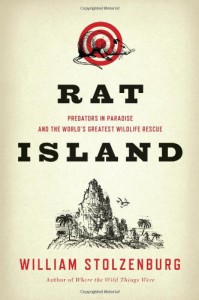 Riveting accounts of invasive species on selected islands and what has been done to eradicate them. This is not just a book about Rat Island, as I had supposed, but includes background on invasive mammals and the history of attempts at their eradication. The ones in this book have been mostly in New Zealand, but also in other places such as Baja California and the Channel Islands. Rat Island is a lead-in to Kiska, which seems to be the ultimate goal. The writing is very suspenseful and what it covers is so little publicized that it is all fresh and new information. This book’s author not only knows who Jared Diamond is, but actually thinks that he has a correction to one of Jared Diamond’s theories. The subject is difficult, and the author may be too biased in favor of island eradications, but he is certainly convincing.
Riveting accounts of invasive species on selected islands and what has been done to eradicate them. This is not just a book about Rat Island, as I had supposed, but includes background on invasive mammals and the history of attempts at their eradication. The ones in this book have been mostly in New Zealand, but also in other places such as Baja California and the Channel Islands. Rat Island is a lead-in to Kiska, which seems to be the ultimate goal. The writing is very suspenseful and what it covers is so little publicized that it is all fresh and new information. This book’s author not only knows who Jared Diamond is, but actually thinks that he has a correction to one of Jared Diamond’s theories. The subject is difficult, and the author may be too biased in favor of island eradications, but he is certainly convincing.
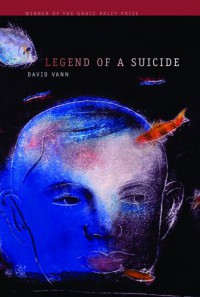 This guy is a good writer and he uses writing for one of its better purposes: to fix what cannot be fixed. He is able to convey a deep feeling of something being much more wrong than it seems until it suddenly becomes truly tragic. There are just a few minor editing problems, such as the use of the word flower instead of flour and a sheep on a mountain in Southeast Alaska, but not enough to keep a reader from becoming immersed.
This guy is a good writer and he uses writing for one of its better purposes: to fix what cannot be fixed. He is able to convey a deep feeling of something being much more wrong than it seems until it suddenly becomes truly tragic. There are just a few minor editing problems, such as the use of the word flower instead of flour and a sheep on a mountain in Southeast Alaska, but not enough to keep a reader from becoming immersed.
 David Quammen has a way with words – his writing uses just the perfect words to enliven the reading experience without burdening it. The essays in this book do not have any thrillingly huge new ideas, just a constant stream of small ones illuminated by Quammen’s point of view. The chapter on Arctic Grayling expresses especially well a love of fish species and understanding of their behavior.
David Quammen has a way with words – his writing uses just the perfect words to enliven the reading experience without burdening it. The essays in this book do not have any thrillingly huge new ideas, just a constant stream of small ones illuminated by Quammen’s point of view. The chapter on Arctic Grayling expresses especially well a love of fish species and understanding of their behavior.
Kahtahah
 Very engaging true book and a good way to get a look at native life from the 18th century. Many Tlingit legends are retold within the main story, too. Like most books, this one omits some details of daily life that would enhance a truer understanding of what that life was like.
Very engaging true book and a good way to get a look at native life from the 18th century. Many Tlingit legends are retold within the main story, too. Like most books, this one omits some details of daily life that would enhance a truer understanding of what that life was like.
J. B. S.: The Life and Times of J.B.S. Haldane
 This is worth reading just to find out who JBS Haldane was and what he did.
This is worth reading just to find out who JBS Haldane was and what he did.With all the contributions JBS Haldane made to physiology, biochemistry and genetics described in this book, I don’t understand why he is not better known. While I had heard his name, I certainly knew nothing about him. His work and life were so wide-ranging that they are difficult to describe. He was an excellent classical scholar and very good mathematician who challenged authority throughout his life. In college, he changed his course of study to what was called “Greats”, or arts, from science, in which he had excelled. He then worked and taught for the rest of his life in science without a degree in science. One of the things for which he is best known is the popular articles he wrote explaining science. He was very active in the Communist party for a while. He believed that animals should not be used for experiments when humans could be used instead, and he used himself in many experiments that sound both dangerous and damaging. These included subjection to varying combinations of cold, pressure, carbon dioxide and oxygen, usually until unconsciousness was reached. In later life, he moved to India and became a vegetarian, while establishing and working at scientific institutions there.
The book is a little hard to read because the author uses British terminology, quite a few references to British institutions, and mentions even small historical events of the time without always explaining them. Beadle is one example of British terminology, and I have only the vaguest idea what a beadle is. This would be a good book to read on an electronic device where you could look up words as you read, but it is probably not available on any of those. Also frequent references to the letters from which he got the material and the author’s constant descriptions of Haldane’s obstinate character prevent the narrative from flowing as well as it might.
Alaska Native Land Claims
 This book gives a good background of Alaskan Native distribution and culture and the major legislation affecting Native Americans before explaining how Alaska Native Claims Settlement Act was developed and the implications of its provisions. Written only 4 years after passage of the Act, there were provisions that had not yet been determined or carried out at the time and the book has a sense of immediacy. The chapters are based upon articles commissioned for this book by a variety of Native authors.
This book gives a good background of Alaskan Native distribution and culture and the major legislation affecting Native Americans before explaining how Alaska Native Claims Settlement Act was developed and the implications of its provisions. Written only 4 years after passage of the Act, there were provisions that had not yet been determined or carried out at the time and the book has a sense of immediacy. The chapters are based upon articles commissioned for this book by a variety of Native authors.
Polar Dream: The First Solo Expedition by a Woman and Her Dog to the Magnetic North Pole
 Astounding. This book shows what humans can do and the dog is a wonderful character, although I would never be tempted to try to anything involving such cold.
Astounding. This book shows what humans can do and the dog is a wonderful character, although I would never be tempted to try to anything involving such cold.
 You Don’t Look Like Anybody I Know is a hard-hitting book. The sheer writing ability swept me off my feet and slipped in between my life and me for the time I was reading it. In addition to seamless writing and an engaging personality, the book has a fascinating story with plenty to think about. I guess I missed the author’s appearance on TV and the ensuing stories, because I had never heard of face-blindness. Apparently, recognizing a face is one separate function of the brain, quite independent of any recognizing any other features or characteristics and having nothing to do with remembering names. People with face-blindness have a failure of that one part of the brain, oddly enough, and this is different from what I experience when I don’t pay enough attention to remember what someone looks like or what their name is. The author, after she understands that she cannot recognize human faces and why she can’t, comes to some conclusions that are useful even in less extreme circumstances than hers. Being honest about those times when one doesn’t remember who someone else is, recognize them, or remember their name, is a good thing to do. Of course, face-blindness is different, and more difficult, I’m sure, than I can understand, but the book certainly reminded me of the feelings of inadequacy coming from one’s own shortcomings-the times when you can’t understand why you are so incompetent at things that are so easy for others. It was easy to relate to the author’s portrayal of hiding unintentional failures and pretending to be something she wasn’t. Her conscious decision to go with honesty was worth keeping in mind
You Don’t Look Like Anybody I Know is a hard-hitting book. The sheer writing ability swept me off my feet and slipped in between my life and me for the time I was reading it. In addition to seamless writing and an engaging personality, the book has a fascinating story with plenty to think about. I guess I missed the author’s appearance on TV and the ensuing stories, because I had never heard of face-blindness. Apparently, recognizing a face is one separate function of the brain, quite independent of any recognizing any other features or characteristics and having nothing to do with remembering names. People with face-blindness have a failure of that one part of the brain, oddly enough, and this is different from what I experience when I don’t pay enough attention to remember what someone looks like or what their name is. The author, after she understands that she cannot recognize human faces and why she can’t, comes to some conclusions that are useful even in less extreme circumstances than hers. Being honest about those times when one doesn’t remember who someone else is, recognize them, or remember their name, is a good thing to do. Of course, face-blindness is different, and more difficult, I’m sure, than I can understand, but the book certainly reminded me of the feelings of inadequacy coming from one’s own shortcomings-the times when you can’t understand why you are so incompetent at things that are so easy for others. It was easy to relate to the author’s portrayal of hiding unintentional failures and pretending to be something she wasn’t. Her conscious decision to go with honesty was worth keeping in mind
Enlightenment And Exploration In The North Pacific 1741-1805
 This is a series of essays by experts from various fields from a symposium held in 1994 to commemorate the bicentennial of George Vancouver's 1792-94 voyage. It has material on Cook, Vancouver, Laperouse, and Malaspina, so, especially for someone like me, who is a bit phobic of this type of history, it is nice to get this overview of exploration voyages. However, this wasn't the fastest I've ever read a book.
This is a series of essays by experts from various fields from a symposium held in 1994 to commemorate the bicentennial of George Vancouver's 1792-94 voyage. It has material on Cook, Vancouver, Laperouse, and Malaspina, so, especially for someone like me, who is a bit phobic of this type of history, it is nice to get this overview of exploration voyages. However, this wasn't the fastest I've ever read a book.
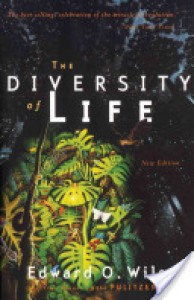 This book does an excellent job of putting the current state of biodiversity in context, both of deep time and the immediate perspective. There are very clear explanations of ecological concepts. The simple title doesn’t convey the threats to biodiversity and the ideas for combating them that are in the book. This book thrilled me because it explains how ecological problems can be addressed, while considering the realities of human needs. I find it endlessly frustrating when conservation advocates don’t offer solutions, and The Diversity of life explains a breadth of solutions to ecological degradation from throughout the world. This couldn’t be done without a quite astounding familiarity with a wide range of ecology.
This book does an excellent job of putting the current state of biodiversity in context, both of deep time and the immediate perspective. There are very clear explanations of ecological concepts. The simple title doesn’t convey the threats to biodiversity and the ideas for combating them that are in the book. This book thrilled me because it explains how ecological problems can be addressed, while considering the realities of human needs. I find it endlessly frustrating when conservation advocates don’t offer solutions, and The Diversity of life explains a breadth of solutions to ecological degradation from throughout the world. This couldn’t be done without a quite astounding familiarity with a wide range of ecology.
The Bitter Waters of Medicine Creek: A Tragic Clash Between White and Native America
 The term "beating a dead horse" comes to mind. There is so much argument for the author's point of view instead of letting the facts speak for themselves that the facts are buried and almost inaccessible. The parenthetical asides keep the narrative from flowing, and many of the asides are only snide insinuations or minute details that would be better suited for an appendix. The book did seem to pick up a bit toward the end when discussing recent history and it sparked my interest in the history of those Indian-owned casinos in Washington.
The term "beating a dead horse" comes to mind. There is so much argument for the author's point of view instead of letting the facts speak for themselves that the facts are buried and almost inaccessible. The parenthetical asides keep the narrative from flowing, and many of the asides are only snide insinuations or minute details that would be better suited for an appendix. The book did seem to pick up a bit toward the end when discussing recent history and it sparked my interest in the history of those Indian-owned casinos in Washington.
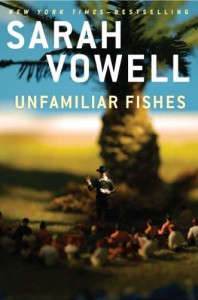 Unfamiliar Fishes is a lovely title, but the book itself feels jumbled. The names and events would be easier to follow if they were presented less as discrete events and the connections between them were more direct. The author jumps back and forth between the historical events and her research of them, which can work as a writing method, but in this case is a little hard to follow. The writing is very clever, which is both funny enough to make you laugh out loud and also distracting. An example is “Loco Moco (a hamburger patty topped with gravy and a fried egg, a dish presumably invented to remedy the hamburger’s most obvious defect–not enough egg).” I don’t even really completely understand this, but it is funny. Humor can be done so that it doesn’t distract from the story, but it wasn’t here.
Unfamiliar Fishes is a lovely title, but the book itself feels jumbled. The names and events would be easier to follow if they were presented less as discrete events and the connections between them were more direct. The author jumps back and forth between the historical events and her research of them, which can work as a writing method, but in this case is a little hard to follow. The writing is very clever, which is both funny enough to make you laugh out loud and also distracting. An example is “Loco Moco (a hamburger patty topped with gravy and a fried egg, a dish presumably invented to remedy the hamburger’s most obvious defect–not enough egg).” I don’t even really completely understand this, but it is funny. Humor can be done so that it doesn’t distract from the story, but it wasn’t here.
 Rick Bragg’s affection for his family and his pride in them shows in this book, and the stories are amusing, if you can get past the violence in the fights. The best part of this book, in my opinion, is the taste of the past that comes through.
Rick Bragg’s affection for his family and his pride in them shows in this book, and the stories are amusing, if you can get past the violence in the fights. The best part of this book, in my opinion, is the taste of the past that comes through.
 The language in this is like I imagined writing by Bob Dylan would be - evocative. He spells out some things in detail and lets you fill in others with your imagination. It gives you a great background in music. Many of Dylan's musical influences surprised me, and inspired me to listen. I was surprised that Dylan was so focused when he began his musical career. I guess I had thought of him, along with some of the other icons of the era as super hip, and I associated being hip with not caring about anything. I have learned during my life that being too cool to care is a losing game, but my impression of Dylan hadn't changed from my teenage years, until I read this book. I found that Dylan had a passion for what he was doing. I also had no idea how widely he had read and studied many art forms in working toward his goal. The last chapter is the best: a joy to read with the style and content merging seamlessly.
The language in this is like I imagined writing by Bob Dylan would be - evocative. He spells out some things in detail and lets you fill in others with your imagination. It gives you a great background in music. Many of Dylan's musical influences surprised me, and inspired me to listen. I was surprised that Dylan was so focused when he began his musical career. I guess I had thought of him, along with some of the other icons of the era as super hip, and I associated being hip with not caring about anything. I have learned during my life that being too cool to care is a losing game, but my impression of Dylan hadn't changed from my teenage years, until I read this book. I found that Dylan had a passion for what he was doing. I also had no idea how widely he had read and studied many art forms in working toward his goal. The last chapter is the best: a joy to read with the style and content merging seamlessly.


